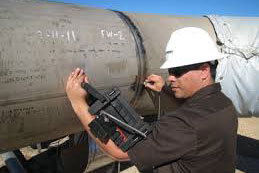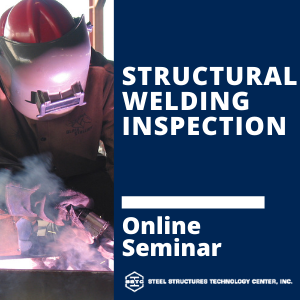Checking Out the Relevance of Welding Assessment in Industrial Applications: Safeguarding Versus Failures and Enhancing Longevity
Welding assessment offers as a crucial line of protection in industrial applications, guaranteeing the structural integrity and reliability of welded components. By systematically identifying defects such as porosity and insufficient fusion, evaluations not only prevent failures however also expand the life-span of vital assets.
Duty of Welding Evaluation
Welding assessment functions as an essential guard in industrial applications, guaranteeing that welded frameworks fulfill specified criteria of high quality and safety and security. This process includes a systematic evaluation of welds to validate their integrity, strength, and conformity with established codes and requirements. The duty of welding inspection is multifaceted, incorporating both visual evaluations and non-destructive screening approaches, which may include ultrasonic, radiographic, or magnetic fragment testing.

Additionally, welding examination plays a vital duty in regulatory conformity. Many sectors are governed by rigorous safety standards, necessitating complete documentation and recognition of welding techniques. By maintaining these documents, companies can show adherence to safety and security regulations, thus promoting trust fund among customers and stakeholders. Eventually, the function of welding inspection is indispensable in advertising security, improving efficiency, and shielding investments in industrial facilities.
Usual Welding Defects

One of one of the most prevalent issues is porosity, characterized by small gas pockets trapped within the weld steel. This takes place as a result of contaminants or inappropriate securing gas, compromising the weld's toughness. An additional considerable issue is incomplete combination, where the weld steel falls short to bond correctly with the base product, potentially causing structural weak points.
Fractures can also establish throughout or after the welding process, usually connected to thermal stresses or improper cooling rates. Furthermore, damaging, where the base steel is worn down along the weld bead, can damage the joint and is typically caused by extreme warm input or inaccurate method.
Moreover, absence of infiltration happens when the weld steel does not reach the root of the joint, leading to inadequate toughness. Comprehending these typical defects is crucial for welders and inspectors alike to ensure that bonded frameworks satisfy safety and security and performance standards, eventually avoiding potential failings in commercial applications.
Advantages of Regular Evaluations
Regular assessments offer as a critical safeguard in ensuring the reliability and longevity of bonded frameworks. These examinations recognize possible problems and weak points that might endanger the stability of welds, permitting timely removal before issues rise. By applying an organized inspection regimen, companies can considerably reduce the danger of disastrous failings that may lead to pricey downtime, devices replacement, and even accidents.
Moreover, routine evaluations add to boosted quality control throughout the welding procedure. By adhering to a constant assessment routine, firms can ensure that their welding methods fulfill well established quality standards and finest techniques. This not just promotes a society of responsibility yet additionally encourages constant renovation among welding workers.
Additionally, routine examinations assist in much better upkeep preparation. By determining wear and tear early, organizations can tactically set up repair work and replacements, decreasing interruption to operations. This positive technique inevitably causes extended asset life expectancy and boosted overall efficiency.
Last but not least, a dedication to routine evaluations can improve a company's track record in the industry. Stakeholders and customers progressively value companies that focus on safety and quality, thereby boosting depend on and possibly bring about increased business opportunities.
Industry Standards and Laws
Abiding by industry standards and guidelines is a fundamental facet of welding assessment that complements the benefits of routine analyses. These standards, developed by organizations such why not try these out as the American Welding Society (AWS) and the American Society of Mechanical Designers (ASME), supply a framework for best methods in welding procedures, products, and inspection strategies. Conformity with these guidelines guarantees that welds satisfy the called for high quality and safety and security standards, significantly minimizing the risk of structural failings.
Governing bodies like the Occupational Safety and Health Administration (OSHA) even more implement standards that secure workers and the atmosphere throughout welding operations. By complying with these established criteria, markets can improve the integrity of their parts and structures, guaranteeing they carry check out here out as planned under various functional problems.
In addition, adherence to sector standards fosters consistency in quality assurance, assisting in smoother interaction among stakeholders and regulative agencies. This alignment not only decreases responsibility threats yet additionally boosts the integrity of organizations in competitive markets. Eventually, compliance with welding requirements and laws is not simply a lawful obligation; it is an essential financial investment in security, performance, and long-lasting functional success.
Future Trends in Welding Assessment
As sectors remain to advance, the future of welding examination is positioned to incorporate sophisticated modern technologies that enhance accuracy and effectiveness. One of one of the most considerable fads is the fostering of automation and robotics in assessment processes. Automated systems can perform inspections swiftly, minimizing human mistake and enhancing throughput in producing settings.
In addition, the assimilation of expert system (AI) and device learning formulas will allow predictive analytics, enabling for real-time assessments and aggressive upkeep (Welding Inspection Gilbert Arizona). By analyzing information from previous examinations, these technologies can recognize patterns that could show possible failings, thereby expanding the lifespan of bonded parts
Additionally, the trend towards digitalization will certainly cause enhanced data administration systems that facilitate better tracking, reporting, and conformity with sector criteria. In recap, the future of welding examination is defined by technological advancements that assure to considerably boost reliability, security, and functional performance in different industrial applications.
Verdict
In verdict, welding examination serves an important feature in making certain the honesty and toughness of bonded frameworks throughout various commercial applications. As improvements in modern technology continue to evolve, the future of welding inspection assures boosted accuracy and performance, inevitably check out this site contributing to the durability of essential facilities.
Welding inspection offers as a critical line of protection in industrial applications, ensuring the architectural integrity and dependability of welded components.Welding examination serves as a crucial safeguard in commercial applications, guaranteeing that bonded frameworks meet defined standards of high quality and safety - Welding Inspection Gilbert Arizona. Ultimately, the function of welding examination is vital in advertising security, enhancing performance, and securing investments in industrial framework
These standards, developed by companies such as the American Welding Culture (AWS) and the American Culture of Mechanical Engineers (ASME), provide a structure for finest techniques in welding procedures, materials, and evaluation techniques.In final thought, welding evaluation offers an essential feature in guaranteeing the integrity and resilience of bonded frameworks throughout different commercial applications.
Comments on “Leading Tips for Effective Welding Inspection in Gilbert Arizona: A Comprehensive Overview”